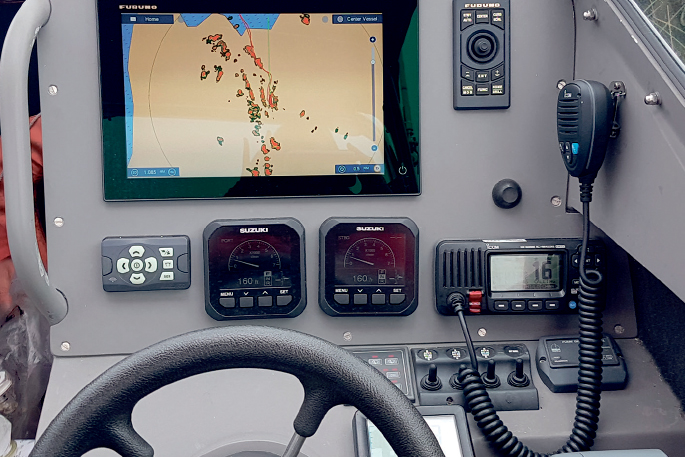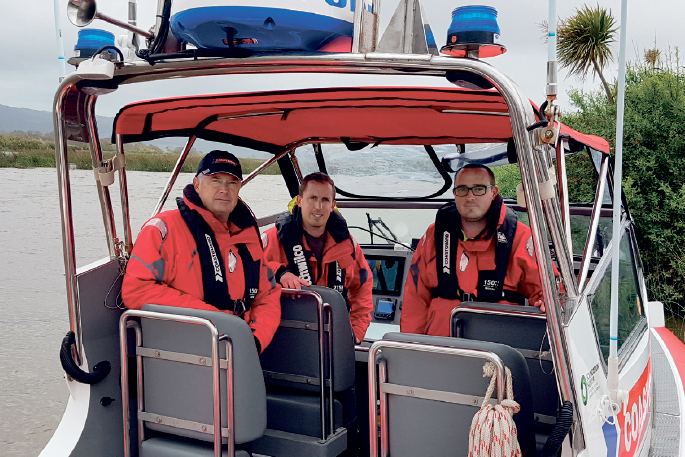I would consider myself fortunate that, for all the hours I have spent on board boats, I have never needed the services of the Coastguard.
Whether because of good safety practices or just good luck, until recently my knowledge of the Coastguard has been minimal.
Nigel Griffiths, the president of the Waiuku Unit, allowed me the opportunity to spend time on-board NZ Steel Rescue, to learn what being a Coastguard member is all about.
Before departure down the Waikato River I am handed a full kit of wet weather gear, a life vest, and given a briefing for on-board safety procedures. Ross Tait (vice president) is at the helm, Karl Dickey on navigation and Nigel is there to provide me with a full commentary on all things Coastguard.
Nigel has been with the Waiuku Coastguard for nine years, is one of the unit’s skippers and was recently elected as a member of the Coastguard NZ Board.
His knowledge and passion for his service is endless, and all three crew members on-board give me the feeling that I am in very safe hands. Ross Tait has been with this unit for 10 years, and tells me the longest serving member with the Waiuku crew is Richard Udy, who has served for around 44 years.
Karl Dickey is currently the rep for Tasman Operations, who set the direction for all Coastguard units in the Waiuku, Papakura, Titirangi, Raglan and Kaipara areas. He’s been with the Waiuku unit for five years.
Waiuku itself is situated 12 kilometres north of the mouth of the Waikato River. It is also located 8.4 kilometres from Kariotahi beach on the west coast. With that much water around, it is easy to decipher that the Waiuku Coastguard have a lot of area to cover.
The full operational area is Manukau Harbour and the Waikato River up to Huntly. Once out to sea they cover up to Kaipara 42nm from the Manukau bar and down to Raglan, 25nm from the port Waikato River bar and 12nm out to sea.
Waiuku Coastguard currently have 30 active members, consisting of wet crew (rescuers) with six skippers among them, and dry crew (field officers). Recruits are taken once a year and it can take up to a year or longer to become a fully qualified Coastguard member.
Given that members have their own jobs to attend, practice with the crew once a week in all weather and are on call for Coastguard duty, I was very appreciative of the time they were giving me.
Even though our trip along the river could be deemed a ‘pleasure cruise’, the crew discuss the sights around them, showing their attention for detail. They point out the new channel markers that have been added, allowing safer passage for vessels.
As we cruise closer to the bar, the crew decide it’s not worth crossing today, as it is fairly rough. “Unlike swimming on the coastline, you look for the calm water to cross a bar,” says Nigel. “Today there is little calm, and the risk just isn’t worth taking.
“Easter two years ago was a very busy time for us, having call outs from both the Manukau and River bars.
“We were sent in search of two fishermen on the Waikato bar. We successfully located the upturned vessel, but unfortunately never located the men.
“It is very hard coming into port and having to give waiting family members bad news.”

Navigation and communication equipment on board.
The unit trains every week no matter the weather conditions, and make use of both the river and harbour waters for their exercises. “The river is uncharted, so we need to spend a fair amount of time there making sure we are familiar with the shifting sand banks,” said Nigel.
“We also use the river for our in-water survivability training. It’s swift moving, colder and less buoyant water really tests our crew. Training in our search techniques are best done in the harbour’s larger, open areas. This includes navigation with charts and lights.
“The Papakura channel is an area in the Manukau Harbour notorious for chopping up quick. It can be perfectly calm one minute, then totally change for the worse.”
One such call for help in this area went out one April evening at around 5pm when a fisherman spotted a 12-foot aluminium boat adrift in the channel.
Vessels from Papakura, Waiuku, Titirangi and Auckland air patrol were all part of the search to locate the missing father and daughter. Hours later, in darkness and mist, the eight-year-old girl was retrieved from the water. With no life jacket, she had been bravely treading water for four hours. The body of the father was located several days later. The teams involved were awarded the Rescue of the Year at the recent Coastguard Northern Region Awards ceremony as well as Coastguard NZ awards, for their dedication in their search for the girl.
My time on-board NZ Steel Rescue reminded me of the importance of skipper responsibility while out on the water, and following simple measures like marine weather checks, providing sufficient life jackets, and the avoidance of alcohol.
Letting someone on shore know of your intentions and having communication equipment on board are all important factors in achieving a positive outcome should an emergency occur.
My time with the Waiuku Coastguard also provided me with an insight into how much effort and commitment Coastguard members contribute to their service, ensuring there is a confident and experienced team available should a call for help be heard.



0 Comments
Leave a Comment